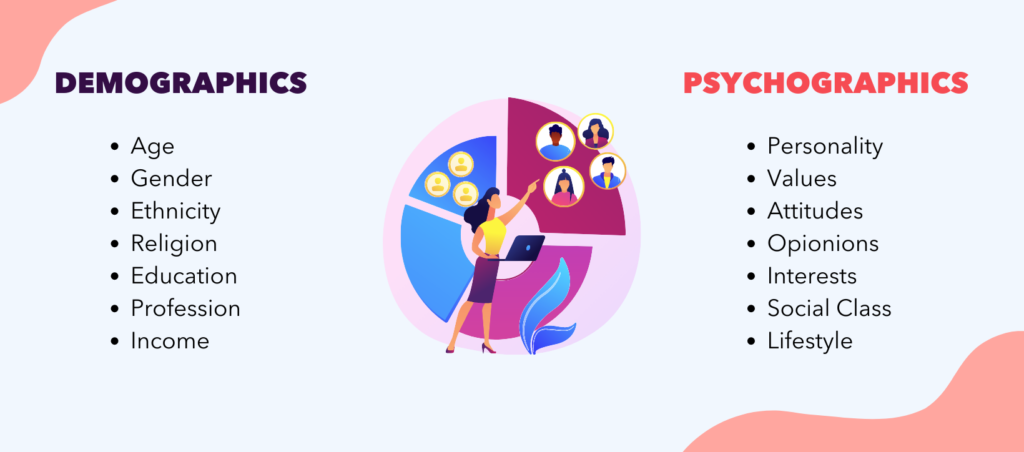As Marketers and Salespeople, we’re constantly selling.
We have our ICPs figured out, we acquaint ourselves with their org structures and learn all about their tech stacks. We seek to consult with their key decision-makers on one hand, while keeping a close eye on our product roadmaps and the moves our competitors are making.
And then we tell ourselves that this is all we need to be able to understand the segment that we’re selling to. Believing this is easy and convenient because it seems enough.
We deny other multiple factors because several of them don’t add up in the linear mathematics of finding why customers buy. But when you step out of that equation and ask for more details, and then some more, is when you finally begin to scratch the surface of the real deal.
We’re talking about psychographics.
What is Psychographics?

Psychographics is the qualitative study of people to classify them on the basis of psychological variables such as their attitudes, values, belief systems, interests, aspirations, fears, and opinions, among others. It is this intimate information that helps marketers and salespeople understand the psyche of their buyers.
Psychographics is the smallest figure of your Matryoshka doll—it’s at the core of it all.
Originally coined by Emanuel Demby, the term was popularized by William Wells in his 1975 article titled ‘Psychographics: A Critical Review’. It took four decades for the term to become a hot buzzword in the field of marketing and sales prospecting after Harvard Business Review featured a piece on the topic.
Initially used in the B2C context, psychographics for B2B is rapidly gaining much acceptance as a concept. The key decision-makers in any organization are human, after all. So, there is no real reason to deny the significance of getting to the depths of people’s minds.
Demographics and Psychographics: The Force-multipliers

Are we saying that psychographics is more important than demographics? Yes, and no.
Yes, because demographics alone won’t answer all of your questions.
No, because demographics is the stepping stone to reaching the heights of profound customer insights.
Demographics is the study of people based on quantitative variables such as gender, age, race, ethnicity, first language, and employment. It is about finding out who your buyer is. While it is enough to chart out your ICP and go after the right audience segment, it may not necessarily move the needle by a stunning degree when it comes to conversions.
Psychographics, as mentioned earlier, attempts to understand why people think and act the way they do. It attempts to answer questions about the IAO variables—Interests, Activities, and Opinions. It tells you why people buy so you know exactly how to help them make that purchase.
While they’re both linked by the common denominator of user insights, what makes the two a whole is the breadth of information that demographics covers and the depths of it that psychographics reaches.
Simply put, demographics discovers the basics, and psychographics seeks anything but.
You can use demographics to determine which of your leads qualify for sales targeting and then you can use more specific psychographic data points to work out your best pitch and your messaging.
Essentially, demographics and psychographics on their own aren’t overly useful. They work best when used in conjunction with each other by building a holistic picture of your audience for you, thereby helping you develop market-driven products.
Psychographic Characteristics That Influence Buying Behavior
As we’ve already established, psychographics attempts to understand why customers buy. It does so by learning less visible traits such as intentions and behaviors. It also includes granular-level data such as hobbies, spending habits, sociological ideologies, and KPIs of their businesses.
Let’s discuss some of the most commonly studied psychographic characteristics:
#1 Personalities

Personality characteristics are those that are either inherent or have been developed through conditioning and are consistently displayed through a person’s words, actions, and responses. These tell you how your buyers interact with the world around them. Are they introverted, extroverted, conscientious, selectively social, or something else?
Example: A car brand is announcing the launch of a new model and aims to capture the millennial segment. The ads can show two of their cars running parallel—one carrying a group of friends (appealing to the extroverts) and the other being driven by a solo female (appealing to the introverts)—reflecting the feelings of excitement and freedom on the faces of both the drivers.
#2 Values

Values are fundamental beliefs that establish one’s sense of right and wrong. These beliefs guide one’s actions and motivate one to behave one way or the other. Values can be influenced by religion, culture, society, and even politics.
Example: If you have prospects who are staunch believers of having a strong work-life balance, you may want to highlight how your product/service not only helps save time but is also capable of handling failovers with minimum manual interference.
#3 Attitudes and Opinions

Attitudes are mental and emotional tendencies to think and feel a certain way. Opinions, on the other hand, are views or judgments about the world we’re surrounded by. While attitudes stem from our belief systems, opinions may not be necessarily based on facts or complete knowledge.
Example: A SaaS-based insurance provider is launching a special healthcare insurance plan for economically backward women on the occasion of International Women’s Day. Their motive is to penetrate the conservative strata of the society that deprioritizes women’s health issues. The brand can have a team of females conduct seminars for women at women’s hospitals/clinics in the presence of female doctors to encourage participation and least resistance from men in the households.
#4 Interests and Hobbies

These tell you about how your buyers prefer spending their time. They could be occupying their time by consuming pop-culture, enjoying social media content, creating art, reading or watching the news, playing a sport, collecting luxury items, or a combination of multiple options like these.
Example: A sports app that allows users to create fantasy leagues during peak sports seasons discovers that a large chunk of its users consists of students who wish to pursue overseas education. The app can partner with international education consultancies and give away promo codes to avail discounts on consultations.
#5 Social Class and Lifestyle Choices

The everyday lifestyle choices of an individual are directly affected by their socio-economic class and status, dictating how they lead their lives and spend their resources. Social class and lifestyle choices, together contribute to decisions such as rented house vs. owned house, economical eateries vs. expensive restaurants, shopping at local shops vs. luxury outlets, etc.
Example: An e-learning app targeting children from all social classes can onboard teachers who are well-versed in regional languages so as to help the non-English-speaking students easily grasp all the concepts in the language they are most familiar with.
Generating Psychographic Data

Knowing what psychographics means and learning about the psychographic characteristics you can use is good, but not merely enough. To successfully implement psychographics into your GTM strategy, you need a method to gather psychographic insights about your prospects.
Here are some ways to go about it:
Sales & Marketing Data Providers
Using a reliable data provider to purchase accurate and updated data is the most viable option for those who are looking to save time and effort.
Before you opt for this, you must ensure that you have a clear idea of what your target audience looks like, and what are the exact data points you need, so you can share the same with your data provider.A sophisticated data provider like Slintel will check all your boxes.
Customer 1:1s
Some businesses, especially service-based, rely on frequent and heavy interaction with their customers. These customer calls are gold mines of information that tell you about your customers’ criteria behind selecting your company over your competitor’s, what motivates them to continue doing business with your company, how likely are they to stick to your brand in the future, etc. In addition to this, these calls also help you learn about the personality type of your customers, their values, beliefs, opinions, attitudes, and a range of other subtle pieces of information.
If you can spot certain trends in the way your customers perceive your product offerings, you can classify these customers based on their shared characteristics, and tailor your sales and marketing messaging to align with what appeals to them.
Although this option is time-consuming and requires proactiveness on your part, the accuracy of the results makes up for the efforts.
Focus Groups
A focus group consists of people who aren’t affiliated with your organization in any way but are aligned with your target audience, and willing to participate in guided discussions about your product or service.
The participants are carefully selected and need to be unbiased to ensure authenticity. If done right, their reactions to your product/service specifications can go a long way in uncovering the needs and requirements of your target audience.
Internal Stakeholders
Don’t forget that there are people within your company who are and have been dealing with acquiring and retaining customers. Experience and observation will have taught them exactly where to look and what to look for when it comes to gathering customer data.
A surefire way to go about extracting this information is by listening to recordings from conversation intelligence software. Dig into your Gong or Wingman recordings of phone and email interactions that your Sales and Customer Success teams have had with your customers. Identifying keywords and setting up triggers to receive alerts every time a keyword is used in these calls makes your job all the more easier.
Long story short, drawing insights from the interactions of your own Sales, Customer Success and Marketing folks is a good way to rack up reliable data points.
Surveys
Gathering first-hand responses to specific questions from a broad group of people can help you understand their buying criteria and priorities.
The insights from these results can be compared against the information that you’ve accumulated through other methods such as your focus groups, internal teams, and customer calls, for drawing reliable inferences.
Psychographics: The Secret Sauce
Paying attention to why customers buy will always leave both parties feeling accomplished because your calculative sales efforts will not only answer the question for you but also justify the purchase for your customers.
This sort of microscopic information can arm you with clues that will help you navigate overcrowded markets without having to scream on top of your voice to be heard.
It will tell you about your target’s spending capacity, help you figure out their lifecycle data from their lifestyle changes, and thus, help you develop sales pitches that ensure healthier closed-won rates.
Ignoring psychographics runs the risk of missed conversion opportunities.
So, the next time two middle-aged ladies—one, a homemaker with two kids, and the other, a single woman and an avid traveler—walk into an electronics store to buy a camera, you know exactly which one of them should hear the pitch that talks about capturing childhoods, and which one should hear about freezing the night bazaars of Istanbul forever in a snapshot.
And that’s psychographics for you!






